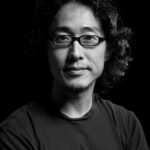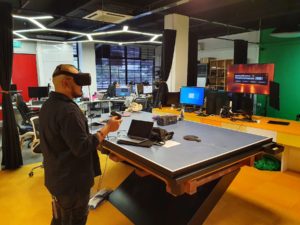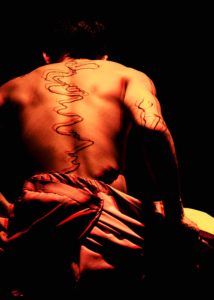Adapting to 360: Kuik Swee Boon’s PheNoumenon goes virtual - Vancouver Ballet Society
- Home
- Features 2020 - 2023
- Adapting to 360: Kuik Swee Boon’s PheNoumenon goes virtual

By Malcolm Tay
When PheNoumenon premiered in December 2019, T.H.E Dance Company tore down the usual border between performers and spectators. Within the Esplanade Theatre Studio’s performance space, viewers could wander amid the action or sit on the floor undisturbed in islets outlined by tape. Punctuating the space were craggy heaps of orange cloth, from which six dancers emerged to envelop the audience in a riot of bone-rattling screams.

The immersive quality of this setup was not lost on artistic director and choreographer Kuik Swee Boon. As COVID-19 put live shows on hold and compelled artists to turn to the screen, Kuik realized that PheNoumenon — which explores humankindʼs relationship with external phenomena — was “perfect to be adapted for 360-degree virtual reality.”
This paved the way for the birth of Singaporeʼs first feature-length VR dance production, which is part of the companyʼs digital series #THEGOESONLINE: Being Virtually Present. The 360-degree VR edition of PheNoumenon is available December 19-31 for viewing at the companyʼs studio in Goodman Arts Centre. In line with safe-distancing measures, there will be a few slots per day to catch an excerpt or the complete version, with limited numbers allowed in the studio at any one time.
Participants can choose to watch from a standing or sitting perspective through an Oculus Quest 2 headset, which has a tracking system that changes what they hear, through earphones, in response to their head movements. Complementing the experience is a scent jointly designed by the troupe and local perfumery Je tʼaime, which company manager Athelyna Swee likens to “a mysterious forest” that “reminds one of nature and the environment we live in.”
While VR has existed for decades, 360-degree video technology has only recently become viable for use in dance. In 2016, Dutch National Ballet released Peter Leungʼs Night Fall, a short film that places the viewer among the corps dancers in a ballet blanc. The BFI London Film Festival launched a free program in October called LFF Expanded, which featured 360-degree VR creations that could be watched online or in person.

VR and its sibling, augmented reality, have surfaced in Singapore, too. During the official reopening celebration of Stamford Arts Centre in 2019, visitors could follow an AR walking trail that introduced the traditional arts groups housed at the centre and let them interact with virtual characters. They could also take a 360-degree VR tour of a hand-built Chinese street opera stage without physically intruding on the space or the performers. Included in the celebration was a mixed-reality performance, in which a real-life dancer moved through a VR realm conceived by a visual artist.
These experiences were developed by Hiverlab, a local firm specializing in immersive media and technology. Kuik was familiar with the firm, having attended its workshop on AR and VR last year, so partnering with Hiverlab seemed the next natural step for developing PheNoumenon in VR.
Taking on a job of this scope, though, was a maiden effort for the six-year-old firm. “This gave us a chance to see how far we could push our capabilities for a feature-length venture,” says project manager Helmut Chan, who had previously tackled brief corporate videos at Hiverlab. The 360-degree VR camera, Chan learned after doing some tests, can record continuously for only 20 to 30 minutes before overheating.

For Kuik, this meant having to adjust the choreography and divide the piece into sections for filming. For the dancers, according to cast member Anthea Seah, the main challenge was “maintaining a smooth journey from take to take,” which required them to “get back quickly into the right mental zone between takes.” After rehearsing for about a month, the troupe returned to the Esplanade Theatre Studio in October, filming PheNoumenon from several viewpoints over four days, with extras posing as spectators.
During filming, however, other obstacles appeared. An unforeseen issue was that what the 360-degree VR camera captures, in particular the darker or vividly lit scenes, tends to differ from what the human eye sees. Lighting designer Adrian Tan, who normally works in the theatre, had to make many tweaks over the course of filming, as what looked good onstage often did not come through on camera. Later, during post-production, Chan continued fine-tuning the footage in discussion with Kuik so that the final product would have a balance of colour, contrast and sharpness.
Also present during filming was sound and systems engineer Guo Ningru, who liaised with composer Kent Lee on recreating the pieceʼs original music and soundscape. “For a live performance, we mix the sound once and everyone in the space hears pretty much the same thing,” notes Guo, a seasoned sound designer for theatrical productions. “But for VR, we have to craft different sound mixes for different perspectives; thatʼs four or five times the amount of work.”
Next year, T.H.E Dance Company plans to have the VR edition of PheNoumenon available at pop-up locations around Singapore and for home rental. To accommodate those new to VR, Hiverlab’s assistant project manager Raphael Seng worked closely with the troupe to make the user interface and experience “as simple and intuitive as possible,” with just a one-hand controller for navigating viewpoints and scenes. The company hopes the home-rental model might reach those who are unable to travel to watch its shows.
For all the prospects that VR offers, Kuik recognizes that this production “can never replace a live performance” and admits that the troupe has been hungry for one. Yet, “by retaining certain characteristics of a live show,” he feels that it narrows the distance with viewers. “We believe that VR technology and digitalization allow us to touch more audiences and will inspire them to come back to the theatre in better times.”

